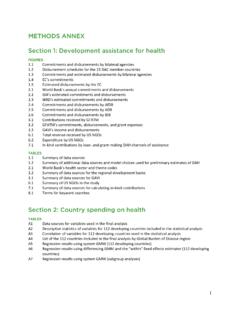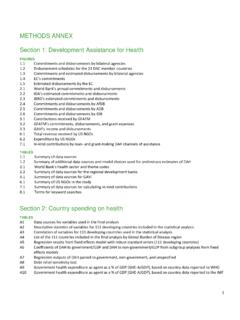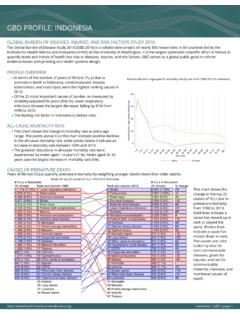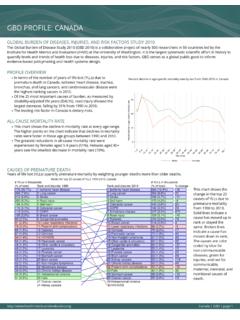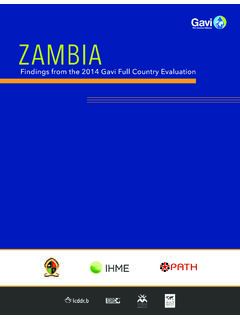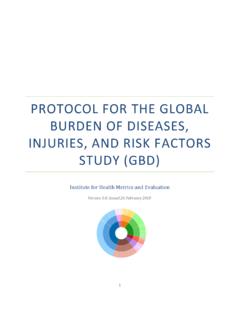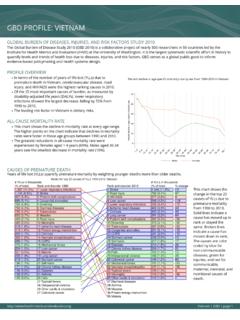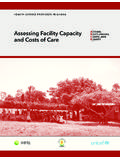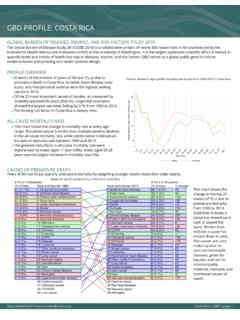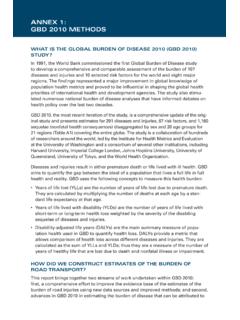Transcription of The Global Burden of Disease: Generating Evidence,
1 The Global Burden of Disease: Generating Evidence, Guiding PolicyINSTITUTE FOR HEALTH METRICS AND EVALUATIONUNIVERSITY OF WASHINGTONThis report was prepared by the Institute for Health Metrics and Evaluation (IHME) based on seven papers for the Global Burden of disease Study 2010 (GBD 2010 ) published in The Lancet (2012 Dec 13; 380). GBD 2010 had 488 co-authors from 303 institutions in 50 countries. The work was made possible through core funding from the Bill & Melinda Gates Foundation. The views expressed are those of the contents of this publication may be reproduced and redistributed in whole or in part, provided the intended use is for noncommercial purposes, the contents are not altered, and full acknowledgment is given to IHME.
2 This work is licensed under the Creative Commons Attribution-NonCommercial-NoDerivs Unported License. To view a copy of this license, please visit For any usage that falls outside of these license restrictions, please contact IHME Communications at Institute for Health Metrics and Evaluation. The Global Burden of disease : Generating evidence , Guiding Policy. Seattle, WA: IHME, for Health Metrics and Evaluation2301 Fifth Ave., Suite 600 Seattle, WA in the United States of AmericaISBN 978-0-9840910-6-5 2013 Institute for Health Metrics and EvaluationGBDIHMEI ntroduction 5 The GBD approach to tracking health progress and challenges 7 Rapid health transitions: GBD 2010 results 15 Using GBD to assess countries health progress 42 Conclusion 44 Annex 46 THE Global Burden OF disease .
3 Generating evidence , GUIDING POLICY4 | GBD 20105 | GBD 2010 Over the last two decades, the Global health landscape has undergone rapid transformation. People around the world are living longer than ever before, and the population is getting older. The number of people in the world is growing. Many countries have made remarkable progress in preventing child deaths. As a result, disease Burden is increasingly defined by disability instead of premature mortality. The leading causes of death and disability have changed from communi-cable diseases in children to non-communicable diseases in adults.
4 Eating too much has overtaken undernutrition as a leading risk factor for illness. These Global trends differ across regions, and nowhere is this contrast more striking than in sub-Saharan Africa. Communicable, maternal, nutritional, and newborn diseases continue to dominate throughout sub-Saharan Africa. The Global Burden of disease (GBD) approach is a systematic, scientific effort to quantify the comparative magnitude of health loss due to diseases, injuries, and risk factors by age, sex, and geography for specific points in time.
5 The latest iteration of that effort, the Global Burden of Diseases, Injuries, and Risk Factors Study 2010 (GBD 2010 ), was published in The Lancet in December 2012. The intent is to create a Global public good that will be useful for informing the design of health systems and the creation of public health policy. It estimates premature death and disability due to 291 diseases and injuries, 1,160 sequelae (direct consequences of disease and injury), and 67 risk factors for 20 age groups and both sexes in 1990, 2005, and 2010 .
6 GBD 2010 produced estimates for 187 countries and 21 regions. In total, the study generated nearly 1 billion estimates of health 2010 was a collaborative effort among 488 researchers from 50 countries and 303 institutions. The Institute for Health Metrics and Evaluation (IHME) acted as the coordinating center for the study. The collaborative strengthened both the data-gathering effort and the quantitative analysis by bringing together some of the foremost minds from a wide range of disciplines. Our intention is to build on this collaborative by enlarging the network in the years to come.
7 Similarly, IHME and its collaborators hope to expand the list of diseases, injuries, and risk factors included in GBD and routinely update the GBD estimates. Continual updates will ensure that the international community can have access to high-quality estimates in the timeli-est fashion. Through sound measurement, we can provide the foundational evidence that will lead to improved population IHMEThe Institute for Health Metrics and Evaluation (IHME) is an independent Global health research center at the University of Washington that provides rigorous and comparable measurement of the world s most important health problems and evalu-ates the strategies used to address them.
8 IHME makes this information freely avail-able so that policymakers have the evidence they need to make informed decisions about how to allocate resources to best improve population express interest in collaborating, participating in GBD training workshops, orreceiving updates of GBD or copies of this publication, please contact IHME at:Institute for Health Metrics and Evaluation2301 Fifth Ave., Suite 600 Seattle, WA 98121 USAT elephone: +1-206-897-2800 Fax: +1-206-897-2899E-mail: Global Burden of disease Study 2010 (GBD 2010 ) was implemented as a col-laboration between seven institutions.
9 The Institute for Health Metrics and Evaluation (IHME) as the coordinating center, the University of Queensland School of Popula-tion Health, Harvard School of Public Health, the Johns Hopkins Bloomberg School of Public Health, the University of Tokyo, Imperial College London, and the World Health Organization. This summary draws on seven GBD 2010 papers published in The Lancet (2012 Dec 13; 380). GBD 2010 had 488 co-authors from 303 institutions in 50 IHME community oversaw the production of this publication.
10 In particular, we thank IHME s Board for their continued leadership. We are grateful to the report s writer Katherine Leach-Kemon; Christopher Murray, Michael MacIntyre, Theo Vos, Rafael Lozano, and William Heisel for content guidance; Summer Ohno for pro-gram coordination; Patricia Kiyono for editing and managing production; and Brian Childress for editorial support. This report would not have been possible without the ongoing contributions of Global Burden of disease collaborators around the world. Finally, we would like to extend our gratitude to the Bill & Melinda Gates Foundationfor generously funding IHME and for its consistent support of the Global Burden ofDisease | GBD 20107 | GBD 2010 Box 1: History of the Global Burden of disease and innovations in GBD 2010 The first GBD study was published as part of the World Development Report 1993.
